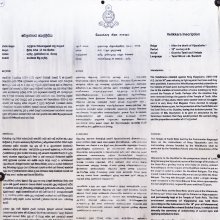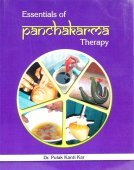Seka, Sekā, Sheka: 23 definitions
Introduction:
Seka means something in Buddhism, Pali, Hinduism, Sanskrit, the history of ancient India, Marathi, biology. If you want to know the exact meaning, history, etymology or English translation of this term then check out the descriptions on this page. Add your comment or reference to a book if you want to contribute to this summary article.
Images (photo gallery)
In Hinduism
Purana and Itihasa (epic history)
Source: archive.org: Puranic EncyclopediaSeka (सेक).—An ancient country in India. It is mentioned in Mahābhārata, Sabhā Parva, Chapter 31, Verse 9, that this country was conquered by Sahadeva during his regional conquest of the south.
Source: JatLand: List of Mahabharata people and placesŚeka (शेक) is a name mentioned in the Mahābhārata (cf. ) and represents one of the many proper names used for people and places. Note: The Mahābhārata (mentioning Śeka) is a Sanskrit epic poem consisting of 100,000 ślokas (metrical verses) and is over 2000 years old.

The Purana (पुराण, purāṇas) refers to Sanskrit literature preserving ancient India’s vast cultural history, including historical legends, religious ceremonies, various arts and sciences. The eighteen mahapuranas total over 400,000 shlokas (metrical couplets) and date to at least several centuries BCE.
Shaivism (Shaiva philosophy)
Source: archive.org: SardhatrisatikalottaragamaSeka (सेक) refers to “sprinkling (the earth)” which is prescribed as one of the operations/ preliminary ceremonies related to the kuṇḍa (“fire-pit”), according to the various Āgamas and related literature. Seka is mentioned in the Mṛgendra-āgama (Kriyā-pāda, chapter 6) and the Acintyaviśvasādākhya (chapter 14).

Shaiva (शैव, śaiva) or Shaivism (śaivism) represents a tradition of Hinduism worshiping Shiva as the supreme being. Closely related to Shaktism, Shaiva literature includes a range of scriptures, including Tantras, while the root of this tradition may be traced back to the ancient Vedas.
Kavya (poetry)
Source: Brill: Śaivism and the Tantric Traditions (kavya)Seka (सेक) refers to “shedding (light)” (e.g., ‘the ornaments shedding light on her cheeks’), according to Bāṇa’s Kādambarī (p. 225-226).—Accordingly, while describing the shire of the Goddess Caṇḍikā, “[Then follows the image of the Goddess Caṇḍikā, which matches the conception of Kālarātri in the passage from the Mahābhārata:] [...] she bore the coquettish apparel of a woman going out to meet Mahākāla at night, with a vine-like body furnished with a raiment reddened with saffron-dye, with a face with red eyes, whose brows were furrowed into a frown, whose lip was crimsoned with betel that was blood, whose cheeks were reddened by the light shed (prabhā-seka) from ear-ornaments of pomegranate flowers, with a forehead on which there was a tilaka dot of vermillion made by a Śabara beauty, covered by a magnificent gold turban. She was worshipped by goats... mice... antelope and black serpents... She was praised on all sides by flocks of old crows; [...]”.

Kavya (काव्य, kavya) refers to Sanskrit poetry, a popular ancient Indian tradition of literature. There have been many Sanskrit poets over the ages, hailing from ancient India and beyond. This topic includes mahakavya, or ‘epic poetry’ and natya, or ‘dramatic poetry’.
Ayurveda (science of life)
Agriculture (Krishi) and Vrikshayurveda (study of Plant life)
Source: Shodhganga: Drumavichitrikarnam—Plant mutagenesis in ancient IndiaSeka (सेक) refers to “sprinkling” or “feeding (the plants) with water” (with various ingredients) according to the bio-organical recipes for plant mutagenesis such as manipulating the scent of flowers, according to the Vṛkṣāyurveda by Sūrapāla (1000 CE): an encyclopedic work dealing with the study of trees and the principles of ancient Indian agriculture.—Accordingly, “Fragrance of the blossom can be changed by filling (the base near) the roots (pūrṇa-mūla) of the trees with the earth scented with the desired fragrance and then fed with water (seka) mixed with Cyperus rotundus, Erythrina stricta, Valeriana wallichii, Aporosa lindleyana and Cinnamomum tamala”.

Āyurveda (आयुर्वेद, ayurveda) is a branch of Indian science dealing with medicine, herbalism, taxology, anatomy, surgery, alchemy and related topics. Traditional practice of Āyurveda in ancient India dates back to at least the first millenium BC. Literature is commonly written in Sanskrit using various poetic metres.
In Buddhism
Tibetan Buddhism (Vajrayana or tantric Buddhism)
Source: academia.edu: A Critical Study of the Vajraḍākamahātantrarāja (II)Sekā (सेका) is the name of a Goddess (Devī) presiding over Mālava: one of the twenty-four sacred districts mentioned in the 9th century Vajraḍākatantra (chapter 18). Her weapons are the mudrā and mudgara. Furthermore, Sekā is accompanied by the Kṣetrapāla (field-protector) named Puṃsasvara and their abode is the madhu-tree.
Source: 84000: Sampuṭodbhava Tantra (Emergence from Sampuṭa)Sekā (सेका) refers to one of the primary thirty-two energy-channels in the body, according to the Sampuṭodbhavatantra chapter 1.—Accordingly, “[Vajragarbha asked, ‘What subtle energy channels are in the body?’]—The Blessed One said, ‘There are one hundred and twenty of them, corresponding to the divisions within the four cakras. The chief ones, those with bodhicitta as their innate nature, are thirty-two in number. They are: [i.e., Sekā] [...]’.”.

Tibetan Buddhism includes schools such as Nyingma, Kadampa, Kagyu and Gelug. Their primary canon of literature is divided in two broad categories: The Kangyur, which consists of Buddha’s words, and the Tengyur, which includes commentaries from various sources. Esotericism and tantra techniques (vajrayāna) are collected indepently.
India history and geography
Source: Cologne Digital Sanskrit Dictionaries: Indian Epigraphical GlossaryŚeka.—(EI 11), same as Sanskrit śikya, a loop or swing made of rope and suspended from the ends of a pole placed on one's shoulder for carrying loads, or the load itself. Cf. saṃkācitaka. Note: śeka is defined in the “Indian epigraphical glossary” as it can be found on ancient inscriptions commonly written in Sanskrit, Prakrit or Dravidian languages.

The history of India traces the identification of countries, villages, towns and other regions of India, as well as mythology, zoology, royal dynasties, rulers, tribes, local festivities and traditions and regional languages. Ancient India enjoyed religious freedom and encourages the path of Dharma, a concept common to Buddhism, Hinduism, and Jainism.
Biology (plants and animals)
Source: Google Books: CRC World Dictionary (Regional names)Seka in Philippines is the name of a plant defined with Calamus caesius in various botanical sources. This page contains potential references in Ayurveda, modern medicine, and other folk traditions or local practices It has the synonym Palmijuncus glaucescens Kuntze (among others).
Example references for further research on medicinal uses or toxicity (see latin names for full list):
· Revisio Generum Plantarum (1891)
· Species Plantarum (1753)
· Rumphia (1847)
· Plant Systematics and Evolution (1994)
· Gardens’ Bulletin, Singapore (1979)
If you are looking for specific details regarding Seka, for example chemical composition, health benefits, side effects, extract dosage, diet and recipes, pregnancy safety, have a look at these references.

This sections includes definitions from the five kingdoms of living things: Animals, Plants, Fungi, Protists and Monera. It will include both the official binomial nomenclature (scientific names usually in Latin) as well as regional spellings and variants.
Languages of India and abroad
Pali-English dictionary
Source: BuddhaSasana: Concise Pali-English Dictionaryseka : (m.) sprinkling.
Source: Sutta: The Pali Text Society's Pali-English DictionarySeka, (fr. sic, see siñcati) sprinkling J. I, 93 (suvaṇṇa-rasa-s. ‹-› piñjara). (Page 722)

Pali is the language of the Tipiṭaka, which is the sacred canon of Theravāda Buddhism and contains much of the Buddha’s speech. Closeley related to Sanskrit, both languages are used interchangeably between religions.
Marathi-English dictionary
Source: DDSA: The Molesworth Marathi and English Dictionaryśēka (शेक).—m ( H) Warming one's self before a fire; or fomentation of a limb or member with heated cloths, leaves, or medicaments. v ghē; and, with v dē, Warming or fomenting another. 2 A little fire of sticks and rubbish (for warming one's self). 3 n C Remuneration for the use of draught cattle.
--- OR ---
sēka (सेक).—m S Sprinkling, aspersion: also sprinkledness.
Source: DDSA: The Aryabhusan school dictionary, Marathi-Englishśēka (शेक).—m Warming one's self before a fire. Fomenting. A little fire of sticks, &c.
--- OR ---
sēka (सेक).—m Sprinkling, aspersion.
Marathi is an Indo-European language having over 70 million native speakers people in (predominantly) Maharashtra India. Marathi, like many other Indo-Aryan languages, evolved from early forms of Prakrit, which itself is a subset of Sanskrit, one of the most ancient languages of the world.
Sanskrit dictionary
Source: DDSA: The practical Sanskrit-English dictionarySeka (सेक).—[sic-ghañ]
1) Sprinkling, watering (trees); सेकः सीकरिणा करेण विहितः कामम् (sekaḥ sīkariṇā kareṇa vihitaḥ kāmam) Uttararāmacarita 3.16; R.1.51;8.45; 16.3;17.16.
2) Emission, effusion.
3) Seminal effusion.
4) A libation, an offering.
5) Seminal fluid; कामतो रेतसः सेकं व्रतस्थस्य द्विजन्मनः (kāmato retasaḥ sekaṃ vratasthasya dvijanmanaḥ) Manusmṛti 11.12.
6) A drop of anything.
7) A shower-bath; Suśr.
Derivable forms: sekaḥ (सेकः).
Source: Cologne Digital Sanskrit Dictionaries: Edgerton Buddhist Hybrid Sanskrit DictionarySeka (सेक).—(m.; Sanskrit id., in lit. sense), lit. sprinkling, so augmentation (‘as of fire by oil’, Bendall): ātmano bahumāno 'yaṃ stutinindādi-sekataḥ, vardhate nārakavaśāt (ms. °śa-) sekān narakavahnivat Śikṣāsamuccaya 265.15—16 (verses).
Source: Cologne Digital Sanskrit Dictionaries: Shabda-Sagara Sanskrit-English DictionarySeka (सेक).—m.
(-kaḥ) 1. Sprinkling, aspersion, as of a fluid, or of Ghee on the sacrificial fire, &c. 2. Seminal effusion. E. ṣic to sprinkle, aff. ghañ .
Source: Cologne Digital Sanskrit Dictionaries: Benfey Sanskrit-English DictionarySeka (सेक).—i. e. sic + a, m. 1. Sprinkling, [Hitopadeśa] ii. [distich] 132; [Kirātārjunīya] 5, 26; a drop (? of fire), [Pañcatantra] i. [distich] 416. 2. Seminal fluid.
Source: Cologne Digital Sanskrit Dictionaries: Cappeller Sanskrit-English DictionarySeka (सेक).—[masculine] sprinkling, watering, out-pouring, effusion, gush.
Source: Cologne Digital Sanskrit Dictionaries: Monier-Williams Sanskrit-English Dictionary1) Seka (सेक):—[from sic] a etc. See sub voce
2) b m. ([from] √sic) pouring out, emission, effusion (as of the seminal fluid; also ‘the fluid itself’), [Ṛg-veda; Manu-smṛti xi, 120]
3) sprinkling, besprinkling, moistening or watering with ([compound]), [Manu-smṛti; Mahābhārata] etc.
4) a shower-bath, [Suśruta; Śārṅgadhara-saṃhitā]
5) a libation, offering, [Monier-Williams’ Sanskrit-English Dictionary]
6) a drop of anything, [ib.]
7) [plural] Name of a people, [ib.]
Source: Cologne Digital Sanskrit Dictionaries: Yates Sanskrit-English Dictionary1) Ṣeka (षेक):—(ṛ ṅa) sekate 1. d. To go.
2) Seka (सेक):—(ṛ, ṅga) sekate 1. d. To go.
3) (kaḥ) 1. m. Sprinkling, injection.
Source: DDSA: Paia-sadda-mahannavo; a comprehensive Prakrit Hindi dictionary (S)Seka (सेक) in the Sanskrit language is related to the Prakrit word: Sea.
[Sanskrit to German]
Sanskrit, also spelled संस्कृतम् (saṃskṛtam), is an ancient language of India commonly seen as the grandmother of the Indo-European language family (even English!). Closely allied with Prakrit and Pali, Sanskrit is more exhaustive in both grammar and terms and has the most extensive collection of literature in the world, greatly surpassing its sister-languages Greek and Latin.
Kannada-English dictionary
Source: Alar: Kannada-English corpusŚēka (ಶೇಕ):—
1) [noun] the quality of being hot; hotness; heat.
2) [noun] much hotness; great warmth; heat.
--- OR ---
Sēka (ಸೇಕ):—
1) [noun] the quality of being hot; hotness; heat.
2) [noun] much hotness; great warmth; heat.
--- OR ---
Sēka (ಸೇಕ):—[noun] = ಸೇಚನೆ [secane].
Kannada is a Dravidian language (as opposed to the Indo-European language family) mainly spoken in the southwestern region of India.
See also (Relevant definitions)
Starts with (+43): Ceka-racacekaram, Cekaccoti, Cekam, Cekan, Cekanmokini, Cekantai, Cekanti, Cekantimuttirai, Cekantiyati, Cekantiyilvai, Cekarakkaran, Cekaran, Cekarancey, Cekarattar, Cekarkuru, Cekatalam, Cekatam, Cekatampikai, Cekati, Cekatkuru.
Ends with (+94): Abhisheka, Abhyutseka, Acaryabhisheka, Adaguseka, Ajyabhisheka, Ambuseka, Amritabhisheka, Amritaseka, Anisheka, Annabhisheka, Anusheka, Anutseka, Aparaseka, Aseka, Atyutseka, Avaseka, Avyaseka, Biseka, Candrabhisheka, Caturthabhisheka.
Full-text (+56): Sekapatra, Sea, Retahseka, Sekamdharapuri, Prasekam, Aseka, Secanaka, Anusheka, Abhisheka, Nisheka, Avaseka, Praseka, Secana, Sekima, Shaikya, Nishekasvara, Nidha, Abhishekabhumipratilambha, Nishekaprakara, Nishekavicara.
Relevant text
Search found 16 books and stories containing Seka, Sekā, Sheka, Śēka, Śeka, Ṣeka, Sēka; (plurals include: Sekas, Sekās, Shekas, Śēkas, Śekas, Ṣekas, Sēkas). You can also click to the full overview containing English textual excerpts. Below are direct links for the most relevant articles:
Rig Veda (translation and commentary) (by H. H. Wilson)
Manusmriti with the Commentary of Medhatithi (by Ganganatha Jha)
Verse 11.120 < [Section XII - Expiation for the Immoral Religious Student (avakīrṇa)]
Sushruta Samhita, Volume 6: Uttara-tantra (by Kaviraj Kunja Lal Bhishagratna)
Chapter XVIII - Preparations and medicinal measures for ocular affections in general < [Canto I - Shalakya-tantra (ears, eyes, nose, mouth and throat)]
Chapter XII - Treatment of Raktaja Ophthalmia < [Canto I - Shalakya-tantra (ears, eyes, nose, mouth and throat)]
Chapter XLVII - Symptoms and Treatment of Alcoholism (Panatyaya) < [Canto III - Kaya-chikitsa-tantra (internal medicine)]
Puranic encyclopaedia (by Vettam Mani)
List of Mahabharata people and places (by Laxman Burdak)
Sushruta Samhita, volume 4: Cikitsasthana (by Kaviraj Kunja Lal Bhishagratna)
Related products


